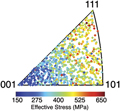Article contents
Correlation between crystallographic orientation and mechanical response in a three-dimensional β-Ti microstructure
Published online by Cambridge University Press: 21 March 2011
Abstract

Three-dimensional image-based modeling is used to investigate the correlations between crystallographic orientation and mechanical response in a body-centered cubic (BCC) β-titanium microstructure. Statistical significance is achieved by combining the simulation data of multiple image-based crystal plasticity models. Each individual model contains ∼100 grains and is subjected to uniaxial and biaxial tensile loading conditions. Although the use of smaller sub-volumes instead of a single large representative volume may preclude accurate prediction of the global stress–strain response of the material, it is demonstrated here that the microstructural and mechanical information at the local (grain) scale can be used to establish statistically significant microstructure–property correlations. It is shown that grains with <100> orientations aligned with the loading axis experienced much smaller effective stresses and strains than those with <110> and <111> orientations aligned with the loading axis under both types of loading conditions.
- Type
- Invited Feature Paper
- Information
- Copyright
- Copyright © Materials Research Society 2011
References
REFERENCES
- 5
- Cited by




